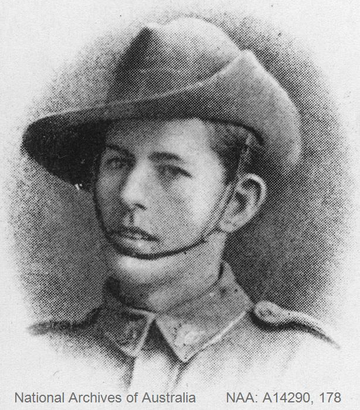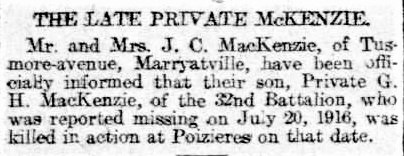George Hector MACKENZIE
Eyes grey, Hair dark brown, Complexion medium
The Search for George Hector Mackenzie
Born to James and Annie Mackenzie in Penola, South Australia, George was the seventh child of eight known offspring, including two boys who died in infancy. James Chalmers Mackenzie had immigrated to Australia in the 1870’s and married Annie Mitchell in 1884, settling initially in Penola where Annie was a storekeeper.
George came from a family of high achievers: his uncle, William Mackenzie 1847-1926, was a stockbroker and managing director of the Alliance Trust Company; his grandfather, James Mackenzie 1819-1869, was a Reverend of the Free Church and a published author on the history of Scotland; and a great-uncle, Robert Mackenzie 1823-81, wrote books on the history of America in the 19th century.
In 1910, the family moved to Marryatville (Knightsbridge) which was on the outskirts of Adelaide at that time. George continued his education at Norwood Primary School and went on to Norwood High School. He was a member of the cadet corps acting as sergeant and as second lieutenant at various times but on his enlistment papers he chose to not disclose this service. After school, he entered the South Australian public service working in the Factories Department.
Keen to enlist
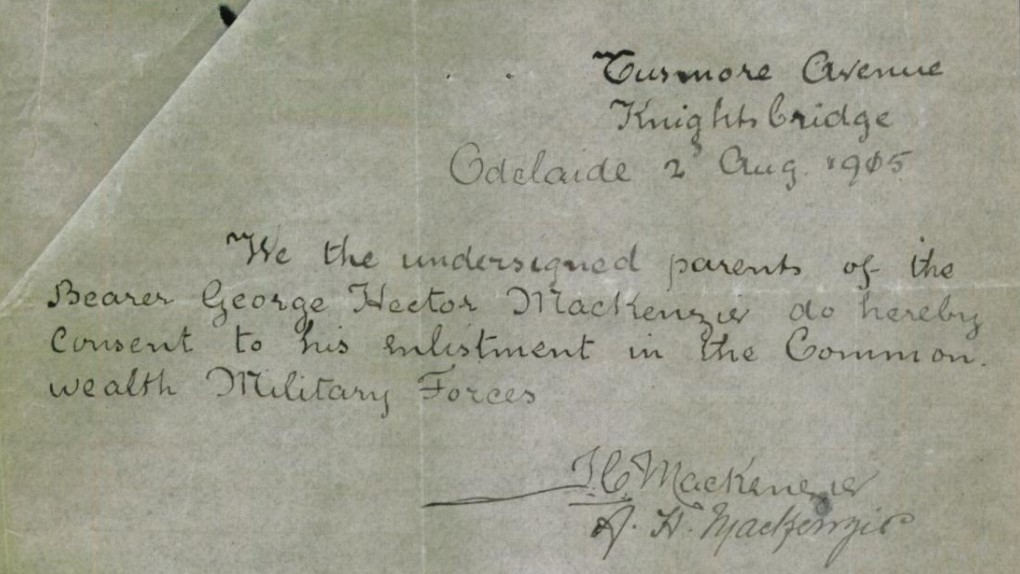
Just weeks after his seventeenth birthday, George signed his enlistment papers adding a year to his age claiming to be eighteen. At nearly 5 feet 11 inches and around 63 kilograms, it seems his age was not questioned. In addition, his parents were required to give consent as he was under twenty-one so it is likely that they knew of, and accepted, his deception. It was perhaps his adjustment to his age that led him to state that he had no prior military training; authorities may have too easily cross-checked his cadet records and noted his true year of birth.
Successful in his enlistment, George was fondly farewelled with a dinner by his colleagues from the Factories Department and presented with a watch. He left Australia in January 1916.
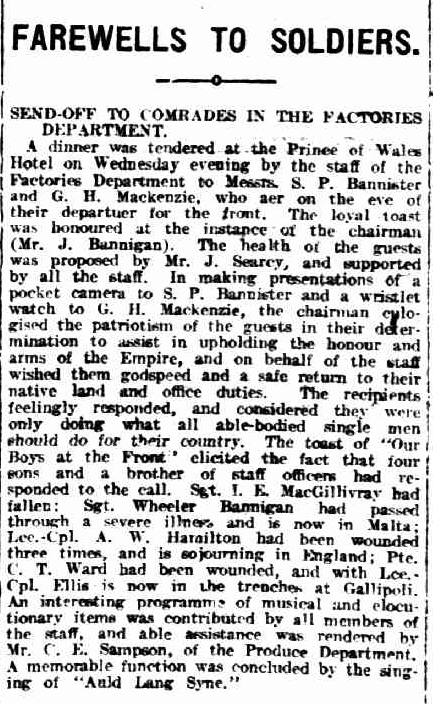
The following article appeared in the local paper in May 1916, a little less than two months before George was destined to meet his fate:
“Sgt G.H. Mackenzie, of Knightsbridge, South Australia, was born at 7 o'clock on the 7th day of the 7th month, and is the 7th child of the family. In the two most important exams. of his scholastic career he passed in 7 subjects on each occasion. In response to the call of his country for "more men," he enlisted, was passed by the doctor on July 7, was drafted to the 7th Reinforcements of the 27th Battalion of the 7th Brigade, and sailed for Egypt on the troopship A7, of which he was appointed orderly sergeant of No. 7 table for the voyage. The vessel en route arrived at Fremantle on January 7 at 7 o'clock. “
The article went on to document numerous other instances of the number 7 featuring during his journey to Egypt and concluded by asking “what’s in a number?” What indeed.
George at War
George was originally assigned to the 27th Battalion and held the rank of acting sergeant. In April 1916, he was transferred to the 32nd Battalion, A Company and reverted to the rank of private as was common practice after disembarkation.
The 32nd Battalion fought its first major battle at Fromelles on 19 July 1916, having only entered the front-line trenches three days previously.
According to the War Diary for the 32nd Battalion (AWM), on the night of the 19th July 1916, Companies A and C were in the front line to form the 1st and 2nd waves over the parapet. At 5.53pm the troops were in position and moved into No Man’s land. By 6.30pm they had moved to the enemy’s first line of defence but little progress was made due to the lack of sandbags and that the ditch was “1 to 2 feet of mud and slush in the bottom”. Heavy bombardment from the German lines continued all night and around 4am the Germans once again attacked.
The attack was a disastrous introduction to battle for the 32nd. It suffered 718 casualties, almost 75 per cent of the battalion's total strength, but closer to 90 per cent of its actual fighting strength.
After the battle, George was officially listed as missing from 20th July 1916 with his family receiving word of his fate in August 1916.
In November 1916, a soldier who was taken prisoner at the Battle of Fromelles – 4156 Lance Corporal Horace James Balcomb – gave a statement through the International Red Cross to the effect that George “was seen by platoon comrade wounded in ‘no man’s land’ on the evening of the 19th July 1916”.

The Search for George
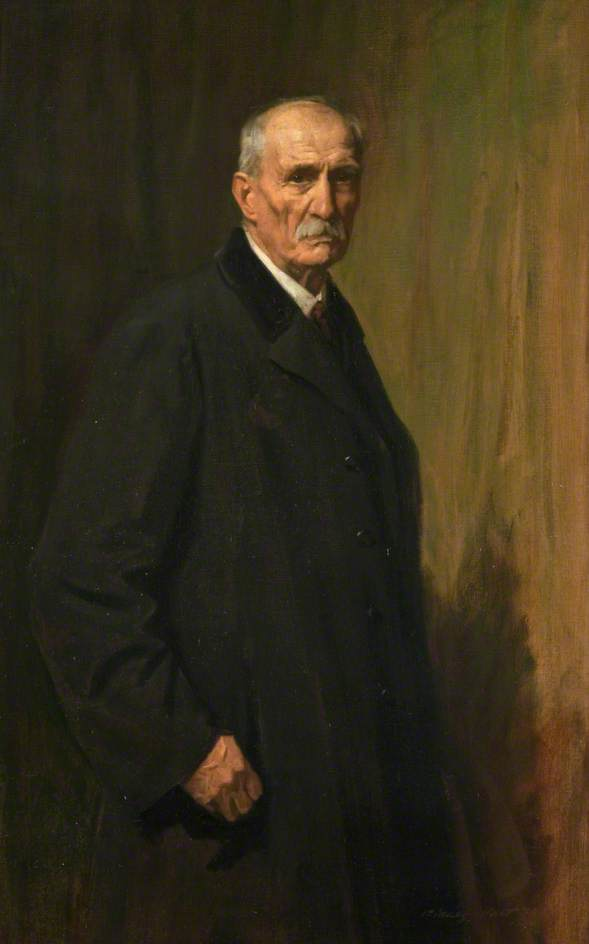
Just as we look to find the lost soldiers of Fromelles today, so did their families. For George, he not only had his immediate family awaiting word and searching for news, but also his Uncle William Mackenzie, a stockbroker and managing director of the Alliance Trust Company from Dundee who corresponded with the Red Cross to enquire on behalf of the family. William also undertook to write to and correspond with a large number of soldiers held as prisoners of war stationed across Germany in his quest to locate George.
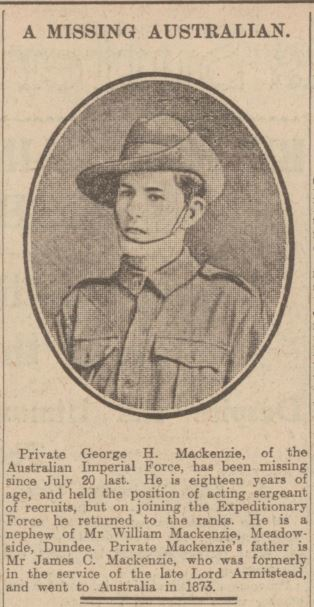
Early correspondence from Uncle William was to the Scottish Red Cross and it was quickly filtered through to the Australian branch. Over the course of the next few years, he would write many letters enquiring on behalf of the family to the various Red Cross organisations across the world.
It is poignant that in one of the first letters (8 September 1916) that he wrote to the Scottish Red Cross he said:
It is therefore all the more distressing to the mother of the boys and the other members of the family that they should at this time be subjected to the awful suspense which is imposed by the terrible word “missing”, and I am doing all I can to shorten this period of anxiety and will be glad to have your assistance.
Earlier in that letter, William gave his nephew George’s details and also referred to another nephew. This was Hamish William Mackenzie 1888-1921, older brother to George, who was an engineer in the British navy doing transport duty but was then recuperating from a serious operation and also seeking news of his youngest brother.
Any word or whisper of a Mackenzie was followed up by Uncle William Mackenzie with a letter and a cheque for 5 pounds to help the Red Cross with the search. William also produced a handbill with George’s photo and details to be circulated to help aid in the search.
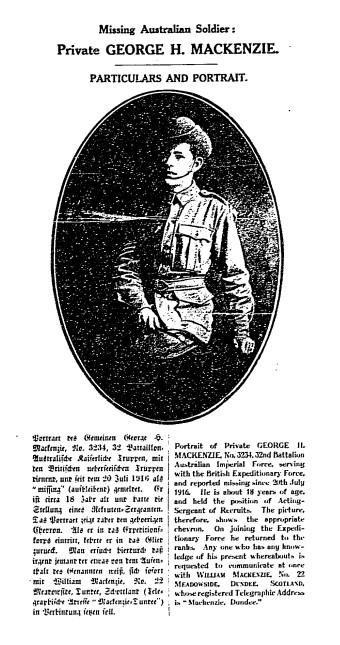
He even made enquiries on behalf of other soldiers that he had contacted, most notably, Wesley Choat, a prisoner of war who lost two brothers, Archibald and Raymond, at Fromelles.
Based on lists provided by the Red Cross, William wrote to many of the Prisoners of War stationed throughout Germany, particularly those who served in the 32nd Battalion with George. This included Theodore Claxton, a prisoner of war at the time. William provided the following update to Vera Deakin of the Red Cross:
Dear Miss Deakin,
Many thanks for your letter…, we have the names of 62 members of the 32nd Battalion who are prisoners. I have written everyone of them, but there has not been time to hear from the last 37. From the good many of the others I have heard, but they are very sorry they can tell me nothing about my nephew.
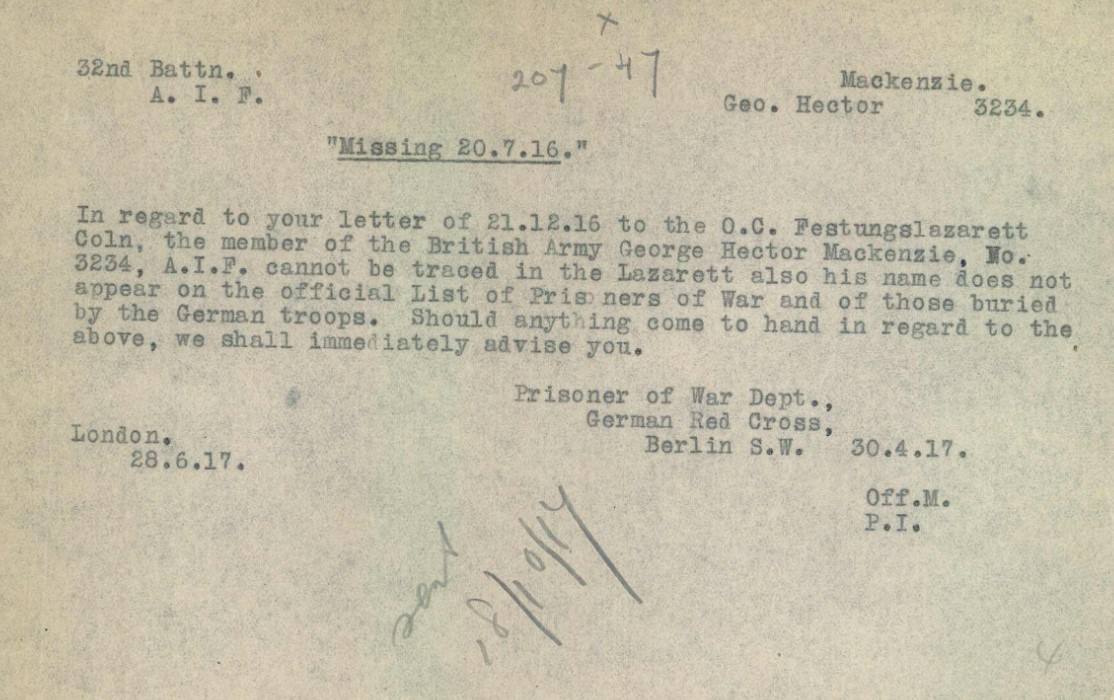
Finally in April 1917, after exhaustive searches, Uncle William seemed to accept that George was killed in action. He wrote:
We have never heard anything at all about my nephew notwithstanding all our enquiries, and have been forced into the sad conclusion that his life was lost when he went missing.
In September 1917 the family back in Australia received official notification that a Court of Enquiry in August 1917 had declared that George was killed in action on 20 July 1916.
In October 1917, William wrote to the Red Cross again:
I have received such a number of kind sympathetic and helpful letters from so many of the Australian prisoners belonging to the 32nd Battalion that I have long wished to thank all of them very heartily for their kindness, but have delayed and delayed in the hope that after all something might probably turn up. This despairing hope has now been definitely and conclusively wiped out by the receipt of an advice from the Administrative Headquarters reporting the result of a Court of Enquiry. I have, therefore, addressed a letter to each of the men who wrote me.
With that letter, he included a list of more than 40 soldiers’ names. Just imagine the hundreds of letters he wrote and received in just over a 12-month period in his desperate search to find his young nephew from Australia. And it is amazing that he still found the time, courage and courtesy to write and thank them all individually!
In 1919, he wrote one last time:
Dear Miss Deakin,
You and your associates kindly took a great deal of trouble on my behalf when I was corresponding with you about the loss of my nephew, Private George H. Mackenzie, 3234 of the 32nd Battalion, A.I.F. Unfortunately, you were unable to discover anything, but now that the Armistice has opened the doors and prisoners are going home, it may be that new light is forthcoming on his fate and the manner in which he met his death, because I do not suppose there is the smallest chance that he is still a prisoner in Germany.
George’s name was again placed on a new enquiry list that was circulated by the Red Cross at the end of the war amongst the returning prisoners of war and in all the camps and hospitals in England, but no further information seems to have come to hand.
George’s oldest sister Helen wrote in 1918 seeking any personal effects to be returned and again in 1921 on behalf of her mother. Information was scarce and little communication had reached them on the fate of their son and brother. No personal effects were ever found.

Tragically, in the next few years after George’s death, the family would also lose some of his brothers and sisters including his sister Annie (1919), brother Hamish (1921), and sister Letitia (1927). George’s parents, James and Annie, passed away in 1931 and 1935 respectively leaving just two surviving children, Helen and Bertha.
Remembered with Honour
George is remembered with honour with his name inscribed on:
- VC Corner Australian Cemetery and Memorial, Fromelles, France, panel 5
- Australian War Memorial Roll of Honour, Canberra, ACT, panel 120
- Norwood Primary School Roll of Honour, panel 2
- Adelaide National War Memorial, Adelaide, South Australia
- Burnside District Fallen Soldiers' Memorial - Rose Park, Adelaide, South Australia
- Memorial statue
- Memorial Tree (tree no. 66 on Prescott Terrace)
- Hazelwood Park (Knightsbridge) War Memorial, Hazelwood Park, City of Burnside, South Australia
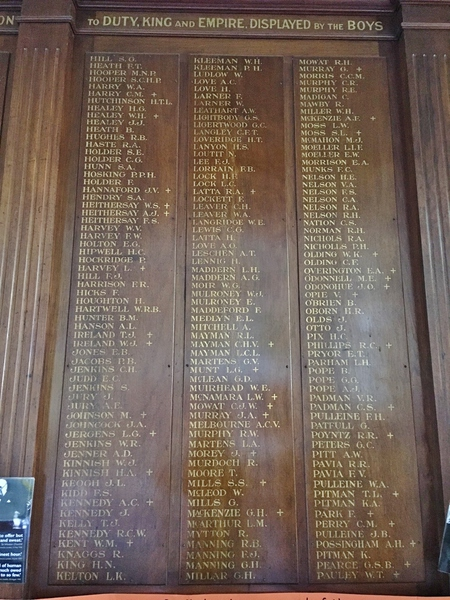
No DNA donors have been located for this soldier and therefore contact with any members of the related, extended Mackenzie family are urgently sought.
If any reader has family connection to either Annie Hamilton (nee MITCHELL) and James Chalmers MACKENZIE, we would very much appreciate contact.
DNA is still being sought for
| Soldier | George Hector MacKENZIE 1898-1916 |
| Parents | James Chalmers MACKENZIE Born 1852, Dunfermline, Scotland, Died 1931, Adelaide, South Australia | ||
| Annie Hamilton MITCHELL Born 1865 Hamilton, South Australia Died 1935, Adelaide, South Australia |
| Grandparents | |||
| Paternal | Rev James MACKENZIE Born 1818, Barry, Scotland Died 1869, Dunfermline and Helen Chalmers MILLAR Born 1819, Crieff, Scotland Died 1901 Edinburgh, Scotland | ||
| Maternal | Thomas MITCHELL Born 1836 Cornwall, Died 1877, South Australia and Letitia Lockyer FRY Born 1844 Wiltshire, Died 1929, Adelaide, South Australia |
Links to Official Records
Seeking DNA Donors

Contacts
(Contact: carla@fromelles.info or geoffrey@fromelles.info).
(Contact: army.uwc@defence.gov.au or phone 1800 019 090).
Donations
If you are able, please contribute to the upkeep of this resource.
(Contact: bill@fromelles.info ).
